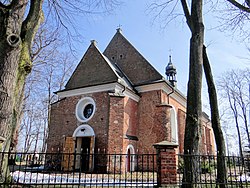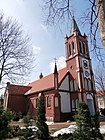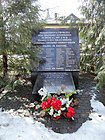Cegłów, Mińsk County (original) (raw)
From Wikipedia, the free encyclopedia
Town in Masovian Voivodeship, Poland
| Cegłów | |
|---|---|
| town | |
 Saint John the Baptist church in Cegłów Saint John the Baptist church in Cegłów |
|
 Coat of arms Coat of arms |
|
  Cegłów Cegłów |
|
| Coordinates: 52°8′45″N 21°44′8″E / 52.14583°N 21.73556°E / 52.14583; 21.73556 | |
| Country |  Poland Poland |
| Voivodeship | Masovian |
| County | Mińsk |
| Gmina | Cegłów |
| Town rights | 1621 |
| Population | |
| • Total | 2,109 |
| Time zone | UTC+1 (CET) |
| • Summer (DST) | UTC+2 (CEST) |
| Vehicle registration | WM |
| Website | Ceglow |
Cegłów [ˈt͡sɛɡwuf] is a town in Mińsk County, Masovian Voivodeship, in east-central Poland. It is the seat of the gmina (administrative district) called Gmina Cegłów.[1] It lies approximately 13 kilometres (8 mi) east of Mińsk Mazowiecki and 51 km (32 mi) east of Warsaw.
The town has a population of 2,109.
Cegłów was granted town rights in 1621 by Polish King Sigismund III Vasa.
In the early 20th century, a Mariavite parish was established in Cegłów, the second after Płock.
Following the joint German-Soviet invasion of Poland, which started World War II in September 1939, Cegłów was occupied by Germany. In December 1939, some expelled Poles from Ostrzeszów were deported to Cegłów.[2] Local Polish railwaymen gave shelter to many Jews who escaped from transports to the Treblinka extermination camp.[3] Polish railwaymen and Jewish escapees jointly carried out acts of sabotage on the Mińsk Mazowiecki-Mrozy railroad, attacking German trains.[3] On June 28, 1943, the German gendarmerie, SS and Gestapo cracked down on the resistance and murdered 26 Poles, including women and children, and an unknown number of Jewish escapees.[4]
There is a train station in Cegłów, and the Polish A2 motorway runs nearby, north of the town.
- ^ "Central Statistical Office (GUS) - TERYT (National Register of Territorial Land Apportionment Journal)" (in Polish). 2008-06-01.
- ^ Graf, Władysław (1992). "Ostrzeszów: obozy jenieckie okresu 1939–1940. Część 2". Zeszyty Ostrzeszowskie (in Polish). No. 16. Ostrzeszowskie Centrum Kultury. p. 30.
- ^ a b Datner, Szymon (1968). Las sprawiedliwych (in Polish). Warszawa: Książka i Wiedza. p. 82.
- ^ Datner, p. 99



